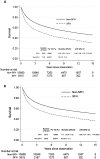Association of financial hardship and survival in working-age patients following cancer diagnosis in Taiwan
- PMID: 40525912
- PMCID: PMC12200238
- DOI: 10.1093/oncolo/oyaf140
Association of financial hardship and survival in working-age patients following cancer diagnosis in Taiwan
Abstract
Background: Extreme income or asset loss as severe form of financial hardship (FH) has been linked to worse survival outcomes in cancer patients. This study aimed to assess the incidence, risk factors, and impact of severe financial hardship (SFH) on survival among working-age cancer patients in Taiwan's universal healthcare system, using an objective measure for SFH.
Methods: This study analyzed linked national longitudinal data for patients aged 20-63 years diagnosed with cancer between 2007 and 2018. Severe financial hardship was defined as household net income falling below the poverty threshold post-diagnosis. Propensity score matching (1:4) was used to balance baseline characteristics between SFH and non-SFH groups. Cox proportional hazard models were used to estimate the hazard ratio (HR) of outcomes.
Results: Among 400 229 working-age cancer patients, the incidence of SFH was 4.7 per 1000 person-years (95% confidence interval [CI], 4.6-4.9) over a mean follow-up of 5.7 ± 4.3 years. Severe financial hardship was associated with younger age, male sex, advanced stage, and intensive treatments. Patients with SFH within 1 year of diagnosis had significantly lower survival, with an adjusted HR of 1.64 (95% CI, 1.56-1.72) for all-cause mortality compared to those without SFH. Notably, early stage patients with SFH faced a higher relative mortality risk than advanced-stage patients.
Conclusions: Severe financial hardship substantially increases mortality among cancer patients in Taiwan, highlighting gaps in financial protection. Addressing SFH through implementing targeted policies and enhancing support mechanisms is essential to improve survival outcomes and reduce disparities in cancer care.
Keywords: cancer; financial hardship; financial toxicity; survival.
© The Author(s) 2025. Published by Oxford University Press.
Conflict of interest statement
Figures




Similar articles
-
Impact of residual disease as a prognostic factor for survival in women with advanced epithelial ovarian cancer after primary surgery.Cochrane Database Syst Rev. 2022 Sep 26;9(9):CD015048. doi: 10.1002/14651858.CD015048.pub2. Cochrane Database Syst Rev. 2022. PMID: 36161421 Free PMC article.
-
A rapid and systematic review of the clinical effectiveness and cost-effectiveness of paclitaxel, docetaxel, gemcitabine and vinorelbine in non-small-cell lung cancer.Health Technol Assess. 2001;5(32):1-195. doi: 10.3310/hta5320. Health Technol Assess. 2001. PMID: 12065068
-
"How am I Going to Live? How am I Going to Pay Rent?": A Mixed Methods Investigation of Employment, Stigma, and Financial Hardship Among LGBTQ+ Cancer Caregivers.Cancer Control. 2025 Jan-Dec;32:10732748251351105. doi: 10.1177/10732748251351105. Epub 2025 Jun 14. Cancer Control. 2025. PMID: 40516028 Free PMC article.
-
Optimisation of chemotherapy and radiotherapy for untreated Hodgkin lymphoma patients with respect to second malignant neoplasms, overall and progression-free survival: individual participant data analysis.Cochrane Database Syst Rev. 2017 Sep 13;9(9):CD008814. doi: 10.1002/14651858.CD008814.pub2. Cochrane Database Syst Rev. 2017. PMID: 28901021 Free PMC article.
-
Cost-effectiveness of using prognostic information to select women with breast cancer for adjuvant systemic therapy.Health Technol Assess. 2006 Sep;10(34):iii-iv, ix-xi, 1-204. doi: 10.3310/hta10340. Health Technol Assess. 2006. PMID: 16959170
References
-
- Yabroff KR, Bradley C, Shih Y-CT.. Understanding financial hardship among cancer survivors in the united states: strategies for prevention and mitigation. J Clin Oncol. 2020;38:292-301. https://doi.org/ 10.1200/jco.19.01564 - DOI - PMC - PubMed
-
- Altice CK, Banegas MP, Tucker-Seeley RD, Yabroff KR.. Financial hardships experienced by cancer survivors: a systematic review. J Natl Cancer Inst. 2017;109:djw205. https://doi.org/ 10.1093/jnci/djw205 - DOI - PMC - PubMed
-
- Yabroff KR, Dowling EC, Guy GP Jr, Banegas MP, et al. Financial hardship associated with cancer in the united states: findings from a population-based sample of adult cancer survivors. J Clin Oncol. 34 (2016) 259-267. https://doi.org/ 10.1200/jco.2015.62.0468 - DOI - PMC - PubMed
-
- Dee EC. Family and caregiver financial toxicity associated with cancer—a global, inequitable, and urgent consideration. JAMA Netw Open 2023;6:e2319317. https://doi.org/ 10.1001/jamanetworkopen.2023.19317 - DOI - PubMed
-
- Ramsey SD, Bansal A, Fedorenko CR, et al. Financial Insolvency as a risk factor for early mortality among patients with cancer. JCO 2016;34:980-986. https://doi.org/ 10.1200/jco.2015.64.6620 - DOI - PMC - PubMed
MeSH terms
LinkOut - more resources
Full Text Sources
Medical
Miscellaneous

